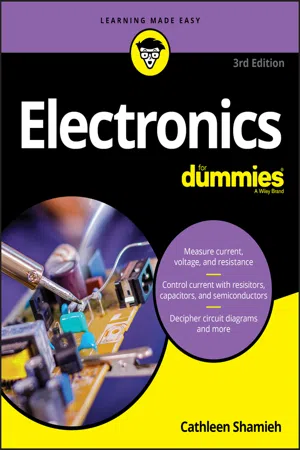Physics
Electric Switch
An electric switch is a device used to interrupt or divert the flow of electric current in a circuit. It typically consists of a mechanism that can be manually operated to open or close the circuit. When the switch is closed, it allows the current to flow, and when it is open, it interrupts the flow of current.
Written by Perlego with AI-assistance
3 Key excerpts on "Electric Switch"
Learn about this page
Index pages curate the most relevant extracts from our library of academic textbooks. They’ve been created using an in-house natural language model (NLM), each adding context and meaning to key research topics.
- eBook - ePub
- Cathleen Shamieh(Author)
- 2019(Publication Date)
- For Dummies(Publisher)
closed position, an electrical connection is made and current flows.Tiny semiconductor transistors (which I discuss in Chapter 10 ) are at the heart of most of the switching that goes on in electronic systems today. The way in which a transistor works is a bit complicated, but the basic idea behind transistor switching is this: You use a small electric current to control the switching action of a transistor, and that switching action controls the flow of a much larger current.Aside from transistor switches, lots of different kinds of mechanical and electrically operated switches can be used in electronics projects. These switches are categorized by how they are controlled, the type and number of connections they make, and how much voltage and current they can handle.Controlling the action of a switch
Switches are referred to by names that indicate how the switching action is controlled. You see some of the many different types of switches in Figure 4-7 .Chances are, you encounter one or more of the following types of switches as you go about your daily routine:FIGURE 4-7: From top to bottom: two toggle switches, a rocker switch, and a leaf switch.- Slide switch: You slide a knob back and forth to open and close this type of switch, which you find on many flashlights.
- Toggle switch: You flip a lever one way to close the switch and the other way to open the switch. You may see labels on these switches: on for the closed position, and off for the open position.
- Rocker switch:
- eBook - ePub
The Really Useful Book of Science Experiments
100 easy ideas for primary school teachers
- Tracy-ann Aston(Author)
- 2015(Publication Date)
- Routledge(Publisher)
Experiment 53Let’s make a switchLearning Objectives:
Design and make a switch for a circuit.Introduction:
The children investigate the best design for a making a switch in a simple series circuit.Useful Prior Work:
The children should be able to build a simple series circuit.Background Science:
Electricity is the flow of electric current. An electric circuit is a connection of electrical components that allow the flow of an electric current. All electric circuits require a power source, usually in the form of a cell (two or more cells make a battery). In order for the electrical current to flow there must be a ‘complete’ circuit, with no gaps or breaks. A switch allows a temporary break in the circuit. When the switch is off or ‘open’, the current can no longer flow around the circuit, therefore the circuit will not work. When the switch is on or ‘closed’, the circuit will be complete again and the electric current will be able to flow around the circuit. There are different types of switches depending on the use of the item. For example, push switches (found in lights) tilt switches (found in electric heaters) and foot switches (found in sewing machines). - eBook - ePub
Instrumentation
An Introduction for Students in the Speech and Hearing Sciences
- T. Newell Decker, Thomas D. Carrell(Authors)
- 2004(Publication Date)
- Psychology Press(Publisher)
Recall that for electricity to flow there must be an imbalance between the net positive charge and the net negative charge. Electricity is generated by causing all the free electrons in a conductor to move in the same direction. To accomplish this there must be, at some beginning point, a generator with two outputs. One of these outputs must maintain an oversupply of free electrons (negative pole), and the other must maintain an undersupply of free electrons (positive pole). If this fundamental condition is maintained, whenever a device (load) is connected across these two outputs (no matter how distant from the source), electricity will flow through the device.WHAT IS AN ELECTRICAL CIRCUIT?
As previously discussed, a closed path of electron movement is needed to have electrical energy in a useful form. This closed path is called an electrical circuit and consists of four basic elements: source, conductor, load, and switch.1. Source. The original source is some electrical generator, but for practical purposes the source may be thought of as the wall outlet.2. Conductor. Conductors are wires that carry the electrical current to the load that will use it. Conductors offer little resistance to the flow of current because the metals they are made of are rich in a supply of free electrons.3. Load. The load is any device that uses the electrical current. The load, unlike the conductor, offers resistance to the flow of the current.4. Switch. This unit in the system provides a method for controlling the energy. A switch controls current flow by placing a very high resistance (air gap) in the way of the current flow when the switch is opened. When the switch is closed, the resistance is removed.Electrical circuits can be classified as either series circuits or parallel circuits . The simple diagram in Fig. 1.10 shows two batteries connected in parallel (Fig. 1.10 a) and in series (Fig. 1.10 b). In the case of the parallel connection the total voltage is 1.5 volts. However, in the series circuit the total is threevolts. Series and parallel circuits also alter the total values of resistors, capacitors, and inductors in a circuit.FIG. 1.10. Series and Parallel circuits.OPEN CIRCUITS AND SHORT CIRCUITS
An open circuit


